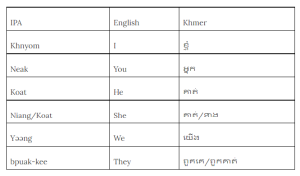1.5 Key Vocabulary and Useful Expressions
| IPA | English |
|---|---|
| bprɔɔ-dteh | country |
| ey/a-vey | what |
| naa | where |
| chmuah | name |
| juab | to meet |
| IPA | English |
|---|---|
| Rik-riay dael baan juab neak. | Nice to meet you. |
| Sok-sa-baay dtee? | How are you? |
| Khnhom sok-sa-baay, ɔɔ-kun. | I am fine, thank you. |
| Khnhom mook bpii bprɔɔ-dteh ii-taa-lii. | I am from Italy. |
| Khnhom chumah ___. | My name is___. |
| Joh-neak-venh? | What about you? |
| Khnhom kɔɔ ey-jəng daer. | Nice to meet you too. |
| Grammar Points | Summary |
|---|---|
| Subject pronouns | There are some common pronouns used by beginners. However, bpuak-kee is replaced by bpuak-koat when the context is clear: the person who is referred to was previously mentioned. The word Niang (she) is not commonly used in spoken language and the word Koat is preferable.
|
| Title nouns | Title nouns such as “look” (Sir, Mr., you for male speaker) and “look-srey” (Madam, Mrs., you for female speaker) can be used as pronouns to denote formality and politeness.
Similarly, when the term “look” is combined with kinship terms such as: Kruu “teacher”; Dtaa “Grandfather”; Bpuu “Uncle”, it denotes respect, politeness, and even endearment.
|
| “Yes” in Khmer | Baat (for male speakers) and Jaa (for female speaker) are the terms for the English word “Yes”. When the word “Baat” or “Jaa” precedes the sentence, it denotes the politeness, for example:
Jaa/baat, Jom-riab-lia, look. = Goodbye, Sir. |


